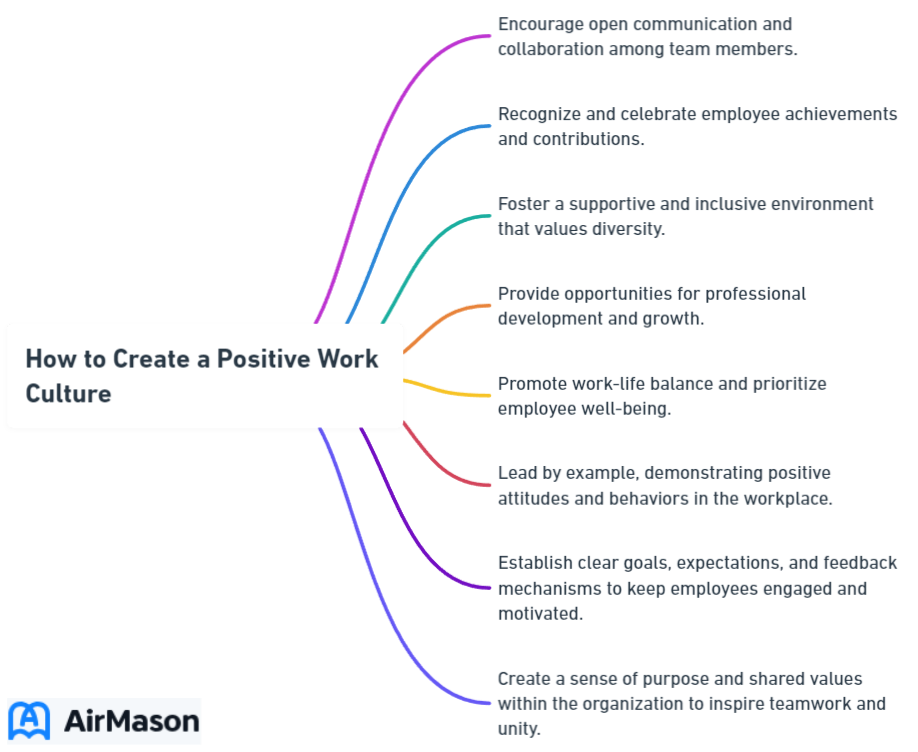
Imagine walking into work every day, feeling inspired, valued, and excited about your job. This is the power of a positive work culture, which can transform employees’ experiences and drive a company’s success. In this article, we’ll explore the importance of work culture, the four types of organizational culture, and the key elements that contribute to a positive work environment. By understanding and implementing these concepts, your organization can thrive and foster a motivated, engaged, and satisfied workforce.
Key Takeaways
- Create a positive work culture by understanding different organizational cultures and fostering open communication, inclusivity, employee recognition, and work-life balance.
- Strategies for cultivating such an environment include defining core values, investing in employee development & promoting well-being.
- Real life examples of successful workplace cultures show that focusing on diversity & growth leads to empowered employees who reach their highest potential.
Understanding Work Culture
A company’s great company culture is like its heartbeat, driving the company values, beliefs, and attitudes that shape the workplace experience. Understanding different company cultures directly impacts employee satisfaction, engagement, and overall success.
Attracting and retaining top talent, boosting employee engagement, and gaining a competitive edge in the market hinges on a healthy workplace culture. To achieve this, it’s essential to improve company culture.
What is Work Culture?
Work culture, also known as organization’s culture, encompasses the collective set of values, beliefs, and attitudes that drive an organization and its employees. It is greatly influenced by:
- Interactions
- Attitudes
- Beliefs
- Traditions
- Values of everyone working in an organization
- Physical environment
Enabling every employee to have a voice can generate fresh ideas and viewpoints, contributing to a healthy culture within an organization. A great work culture can lead to increased productivity and employee satisfaction, creating a positive and thriving environment for everyone involved.

Why is Work Culture Important?
Employee retention, engagement, productivity, and overall business success are heavily influenced by a positive work culture. It can have a profound impact on employees’ well-being, fostering personal growth, innovation, and collaboration. When employees feel valued and heard, they are more likely to be engaged, committed, and productive, leading to a better work experience for everyone.
Moreover, positive social connections at work have been shown to improve overall health, well-being, and job performance. In short, a positive work culture is the foundation for a thriving organization.
The Four Types of Organizational Culture
Organizational culture can be categorized into four types: Clan, Adhocracy, Hierarchy, and Market, each with unique characteristics and challenges. Understanding these four categories can help organizations shape their work culture to best suit their goals, values, and employees.
We’ll examine each type and their key aspects, focusing on what each one looks like.
An Organization’s Culture
An organization’s culture encompasses the shared values, beliefs, and norms that define its identity and guide the behavior of its members. It is the collective essence that shapes how individuals within the organization interact, make decisions, and pursue their objectives. This culture serves as the foundation upon which the organization’s vision and mission are built, providing a framework for employees to align their efforts towards common goals. An organization’s culture can manifest in various forms, ranging from a collaborative and innovative environment to one that prioritizes efficiency and hierarchy. Furthermore, it influences recruitment, retention, and overall employee satisfaction, playing a crucial role in shaping the company’s reputation both internally and externally. Ultimately, a well-cultivated organizational culture not only fosters a sense of belonging among its members but also contributes significantly to the organization’s success and long-term sustainability.
Clan Culture
Clan cultures prioritize teamwork, mentorship, and employee engagement, fostering strong bonds and a sense of belonging among team members. They emphasize active participation, mutual trust, open communication, and collaboration, creating a supportive and encouraging work environment.
However, as businesses grow, maintaining a clan culture can be challenging due to the increased complexity of relationships and the need for more formalized structures. Despite these challenges, a clan culture remains a powerful force for employee engagement and satisfaction.
Adhocracy Culture
Adhocracy cultures are characterized by their flexibility, innovation, and adaptability, making them ideal for startups and technology companies. They encourage employees to think outside the box and come up with creative solutions, fostering a culture of experimentation and rapid transformation. Some notable examples of adhocracy cultures include Google, Tesla, and Amazon.
However, this type of culture may not be suitable for all organizations, as it can lead to communication gaps, lack of structure, and uncertainty.
Hierarchy Culture
Hierarchy cultures value structure, order, and control, making them an excellent choice for organizations that require stability and predictability. They are focused on rules, regulations, and processes, allowing for clear decision-making and communication between different levels of management.
While hierarchy cultures can provide efficiency and effectiveness in the workplace, they may also hinder adaptability and responsiveness, potentially stifling innovation and growth.
Market Culture
Market cultures emphasize:
- Competition and external results
- Meeting customer needs
- Outperforming competitors
- Achieving financial success
They motivate employees to be performance-oriented and contribute to the overall success of the organization. However, the pressure to perform and achieve results can lead to burnout, stress, and a toxic work environment, making it essential for organizations to balance the competitive nature of a market culture with employee well-being.
Key Elements of a Positive Work Culture

A positive work culture is characterized by:
- Open communication
- Inclusivity
- Employee recognition
- Work-life balance
These key elements help to create a supportive and nurturing environment where employees can thrive and excel in their roles.
We’ll explore each of these elements in depth, understanding how they contribute to a positive work culture.
Open Communication
Open communication fosters trust, collaboration, and problem-solving in the workplace. Creating a culture of honesty and transparency that promotes innovation and growth is possible when organizations encourage employees to share their ideas, opinions, and feedback. It is essential for leaders to be approachable and accessible, ensuring that employees feel comfortable sharing their thoughts and concerns.
This open dialogue helps to build a supportive and inclusive work environment, where everyone’s voice is valued and respected.
Inclusivity and Diversity
Inclusivity and diversity create a welcoming work environment that values individual differences and perspectives. By embracing and celebrating the unique identities and experiences of employees, organizations can foster a sense of belonging and unity among team members. This inclusive and diverse culture not only improves employee satisfaction and engagement but also drives:
- Innovation
- Creativity
- Collaboration
- Problem-solving
By bringing together a wide range of ideas and viewpoints, organizations can tap into the full potential of their workforce and achieve greater success.
Employee Recognition and Support
Empowering employees to grow and succeed in their roles hinges on recognition and support. By acknowledging and rewarding employee accomplishments, organizations can build a culture of appreciation and motivation that encourages employees to reach their full potential. This recognition not only boosts employee morale and job satisfaction but also fosters a sense of pride and ownership in their work, leading to increased productivity and innovation.
Work-Life Balance
Employee well-being, satisfaction, and productivity are heavily influenced by work-life balance. By offering flexible work arrangements, mental health support, and social events, organizations can help employees maintain a healthy balance between their professional and personal lives. This balance not only improves employee well-being but also contributes to a positive work culture, where employees feel valued, supported, and motivated to excel in their roles.
Culture of Work: Shaping Productivity and Engagement
The culture of work within an organization encompasses a complex interplay of values, norms, and behaviors that define how individuals and teams operate. A robust culture of work fosters an environment where employees feel motivated, empowered, and aligned with the company’s mission. It sets the tone for productivity, innovation, and collaboration. In a positive culture of work, individuals are encouraged to voice their opinions, take initiative, and contribute meaningfully to the collective goals. Moreover, it goes beyond mere policies; it becomes an integral part of the company’s DNA, influencing hiring decisions, promotions, and even the way challenges are tackled. In essence, a well-cultivated culture of work is the cornerstone of a thriving and sustainable organization.
Strategies for Cultivating a Positive Work Culture

Cultivating a positive work culture involves:
- Defining core values
- Fostering teamwork
- Investing in employee development
- Promoting well-being
By implementing these strategies, organizations can create a supportive and nurturing environment where employees can thrive and excel in their roles.
We’ll examine each of these long term strategies more thoroughly.
Define and Communicate Core Values

Guiding organizational behavior and decision-making hinges on clearly defining and communicating core values. By establishing a strong set of values that align with the company’s mission and vision, organizations can create a solid foundation for their work culture. These values not only set the tone for the workplace but also serve as a compass for employees, ensuring that everyone is working towards the same goals and objectives.
Foster Teamwork and Collaboration
Encouraging teamwork and collaboration is key to creating a positive work culture. By promoting regular check-ins, feedback, and problem-solving sessions, organizations can foster a sense of unity and belonging among employees.
This collaborative environment not only improves employee satisfaction and engagement but also drives innovation and growth by bringing together a wide range of ideas and viewpoints.
Invest in Employee Development
Creating a positive work culture hinges on investing in employee development. By offering training, mentorship, and opportunities for growth, organizations can empower employees to reach their full potential and excel in their roles. This investment not only boosts employee satisfaction and engagement but also contributes to the overall success of the organization, as employees are equipped with the skills and knowledge needed to drive innovation and growth.
Promote Employee Well-Being
Creating a positive work culture is heavily influenced by prioritizing employee well-being. By offering flexible work arrangements, mental health support, and social events, organizations can help employees maintain a healthy balance between their professional and personal lives. This balance not only improves employee well-being but also contributes to a positive work culture, where employees feel valued, supported, and motivated to excel in their roles.
Real-Life Examples of Positive Work Cultures

Companies like Twitter, Etsy, and Costco exemplify positive work cultures through their commitment to employee well-being, inclusivity, and growth. These organizations have successfully implemented the key elements of a positive work culture, resulting in motivated and engaged employees who are driven to excel in their roles.
We’ll examine each of these companies more thoroughly and learn from their inspiring work cultures.
Twitter’s work culture is driven by a shared mission to empower everyone to create and share ideas and information instantly, without barriers. They foster a culture of:
- Diversity
- Inclusion
- Valuing employees
- Support
By promoting open communication and collaboration among team members, Twitter creates a positive and inspiring work environment where employees are encouraged to bring their best selves to work every day.
Etsy
Etsy supports personal expression, work-life balance, and professional development for its employees. By creating an inclusive and diverse workplace, Etsy fosters a sense of belonging and unity among its team members.
They also prioritize employee well-being by offering flexible work arrangements and mental health support, ensuring that employees can maintain a healthy balance between their personal and professional lives, which is something employees want.
Costco
Costco’s work culture includes:
- Encouraging employee participation, initiative, and open communication
- Prioritizing employee well-being by offering generous compensation and benefits
- Providing a supportive and inclusive work environment
By focusing on employee engagement and satisfaction, Costco has created a positive work culture that drives innovation, growth, and success for the company.
Open Culture: Fostering Collaboration and Innovation
Open culture, at its core, embodies a workplace environment that encourages transparency, inclusivity, and the free flow of ideas. It cultivates a sense of belonging and empowers individuals to express themselves without fear of judgment or reprisal. In organizations with an open culture, there is a genuine belief in the value of diverse perspectives, which leads to richer, more innovative solutions. This ethos extends beyond hierarchical boundaries, allowing employees at all levels to contribute and participate in decision-making processes. Moreover, an open culture also embraces adaptability, acknowledging that change is an integral part of growth, and encourages continuous learning and improvement. By fostering an environment where ideas flourish and collaboration thrives, open culture paves the way for organizations to not only weather challenges, but to truly excel in today’s rapidly evolving landscape.
Common Challenges and Solutions
Creating a positive work culture is not without its challenges. Organizations may face resistance to change, struggle to maintain culture during growth, and need to balance flexibility with structure. However, by addressing these challenges head-on and implementing effective strategies, organizations can overcome these obstacles and create an inspiring and supportive work environment.
We’ll examine some common challenges and their potential solutions.
Resistance to Change

Addressing resistance to change involves involving employees in the change process, providing support, and celebrating successes. By acknowledging employee concerns and fears, organizations can create a sense of trust and buy-in among team members, ensuring that everyone is on board with the changes.
Additionally, celebrating successes, even small ones, can help to create a positive reinforcement of the outcomes of change and encourage employees to embrace the new direction.
Maintaining Culture During Growth
Paragraph 1: Maintaining a positive work culture during growth can be achieved by staying true to core values and adapting strategies as needed. By ensuring that new hires align with the company’s values and culture, organizations can create a cohesive team that continues to embody the positive work culture even as the company expands.
Additionally, regularly communicating and reinforcing the company’s mission and values can help maintain a strong sense of identity and purpose among employees, even as the organization grows and evolves.
Balancing Flexibility and Structure
Balancing flexibility and structure in the workplace can be achieved by setting clear expectations, providing guidance, and allowing for autonomy. By providing employees with the tools and resources they need to succeed, organizations can create a supportive and flexible work environment that encourages innovation and growth.
At the same time, maintaining a clear structure and set of guidelines can help ensure consistency and alignment across the organization, allowing employees to understand their roles and responsibilities within the larger framework. To achieve this, it’s important to make sure that everyone is on the same page.
Summary
In conclusion, a positive work culture is the foundation for a thriving, successful organization. By understanding the key elements of a positive work environment and implementing effective strategies, organizations can create a supportive and inspiring workplace that fosters employee engagement, satisfaction, and well-being. Embrace the power of a positive work culture and watch as your organization reaches new heights of success and growth.
Frequently Asked Questions
How do you define work culture?
Work culture is the collective attitudes, values, beliefs and behaviors of employees within an organization that are shaped by leadership, work environment, policies, goals, values, and mission. It creates the shared experience of those working in the company and the atmosphere of the workplace.
What is work culture examples?
Recognizing employees, offering mentorship and support for mental health, and actively promoting social justice are all great examples of work culture initiatives. Consider these examples for inspiration and ideas for creating your own amazing company culture.
What is a healthy work culture?
A healthy work culture is one that prioritizes employee well-being, offers support and respect, provides opportunities for growth and development, and encourages trust and empathy. This creates an environment where employees feel valued, safe, and comfortable.
What are the four types of organizational culture?
Organizational culture comes in four distinct flavors: Clan, Adhocracy, Hierarchy, and Market, each offering its own unique benefits.
How can open communication contribute to a positive work culture?
Open communication encourages trust, collaboration, and problem-solving, creating a positive atmosphere in the workplace that is conducive to productivity and success.